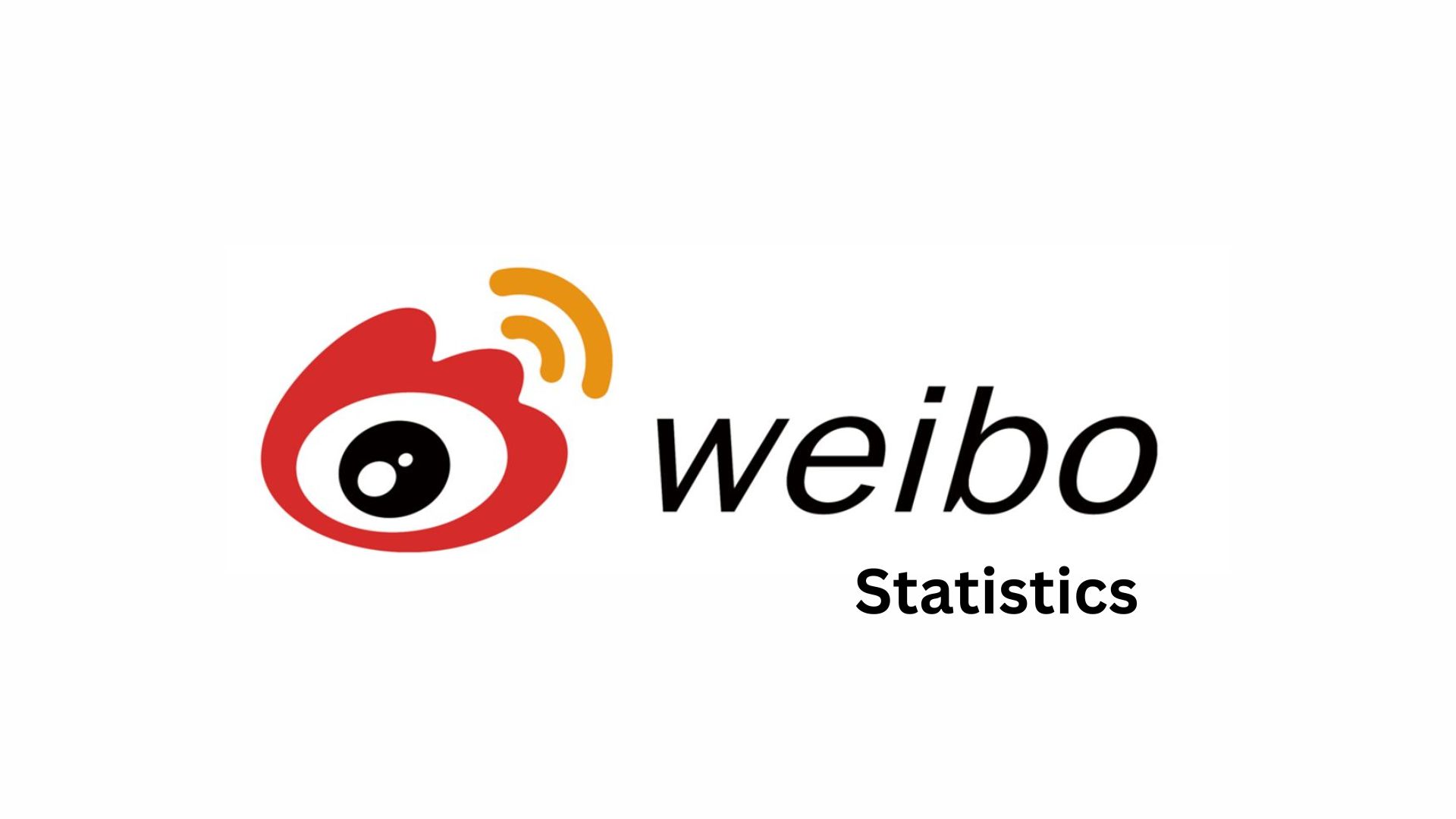Magento Statistics By Market Share, Stores, Sales And Trends (2025)
Updated · Aug 20, 2025
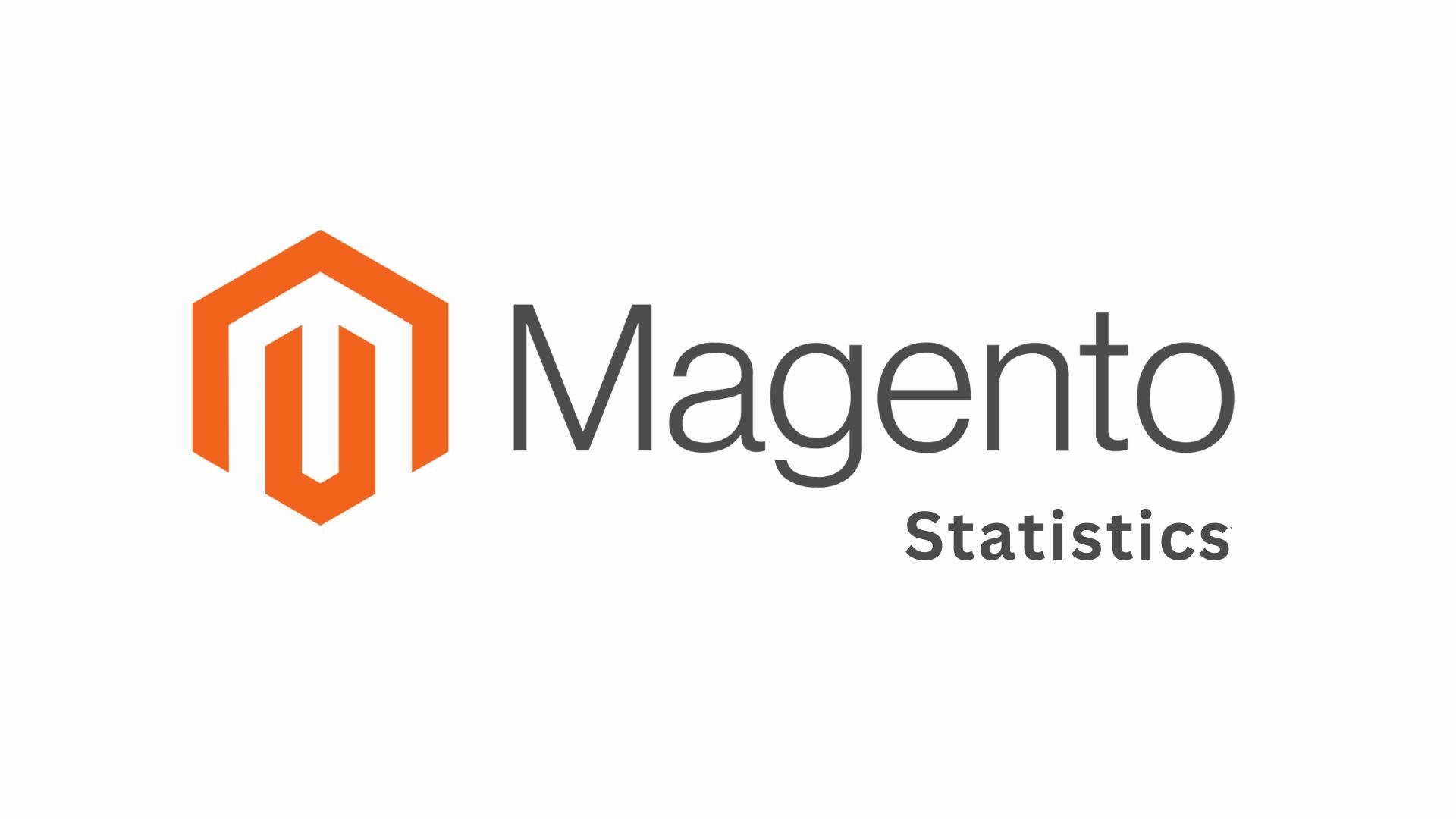
Table of Contents
- Introduction
- Editor’s Choice
- Magento’s Market Statistics
- Magento Events Timeline
- Active Stores of Magento Statistics by Quarter
- Magento Sales Volume Statistics
- Magento Stores Statistics by Social Media Usage
- By Top Apps
- By Top Categories
- By Number of Products Sold
- By Number of Employees
- By Top Technologies
- By Top Shipping Carriers
- By Top-level Domain
- Magento Website Statistics by Country
- By Top Categories
- Comparison Statistics Between Magento 1 and Magento 2
- Magento Marketing Statistics by Google Marketing Tools
- Magento Performance Statistics
- Conclusion
Introduction
Magento Statistics: Magento is a globally popular open-source e-commerce platform that enables all sizes of businesses to create flexible and personalized online stores. Created by Varien Inc. in California and built on PHP, it benefits from contributions by volunteers and the open-source community, making it a collaborative and adaptable tool for online selling.
The platform’s first public beta appeared on August 31, 2007. Merchants favor Magento for its product management tools, SEO features, and simple integrations, which help boost sales and keep customers engaged. Thanks to active developer support and regular updates, Magento continues to be a top choice. This article looks at its usage, market share, trends, and global e-commerce impact.
Editor’s Choice
- According to MGT-Commerce, by the end of Q4 2024, Magento was used by around 131,491 websites across the globe.
- Magento got its name and logo idea from the famous game Dungeons and Dragons.
- It supports more than 30 languages, such as Farsi, Norwegian, Estonian, and Thai.
- magecomp.com further represents that more than 240,000 websites worldwide currently use Magento.
- Its open-source version has been downloaded more than 2.5 million times.
- Magecomp.com, a major U.S. tool retailer, is one of the largest Magento sites, drawing about 40 million monthly visitors.
- Additionally, over 20,000 small businesses rely on Magento for their online store operations.
- Since 2018, Magento’s share in the market has tripled.
- Meetanshi.com also shows that Adobe launched the latest Magento version, 2.4.8, on April 9, 2024.
- Every year, Magento handles online transactions worth around USD 155 billion, as mentioned in a report published by Magefan.
- Magento is an online store platform built with PHP, using the Zend Framework and the MVC pattern to organise its structure.
Magento’s Market Statistics
- According to MGT-Commerce, by the end of Q4 2024, Magento was used by around 131,491 websites across the globe.
- The platform holds about 8% of the worldwide e-commerce market, meaning roughly 8 in every 100 online stores run on Magento.
- It includes both the open-source edition and the Adobe Commerce version.
- In Q2 2024, Magento’s growth rose by 25% compared to the same period the previous year.
- Among the top 10,000 e-commerce sites globally, it ranks in third place.
- The United States accounts for nearly 13% of all Magento-powered stores.
- The official Magento community has over 480,667 active members and more than 210,000 posts, as per Meetanshi.com.
- On Reddit, the Magento and Magento 2 communities together have over 11,000 members.
- LinkedIn lists more than 168,000 professionals who work directly or indirectly with Magento.
- Worldwide, over 14,000 companies and agencies offer Magento-related services and solutions.
- As per Magefan report analysis, Magento’s community provides over 3,890 different extensions to enhance store features.
- Around 200 Magento-powered stores are included in the top 1,000 online retailers list.
- The official Adobe forum for Magento has close to 482,820 members actively participating in the open-source community.
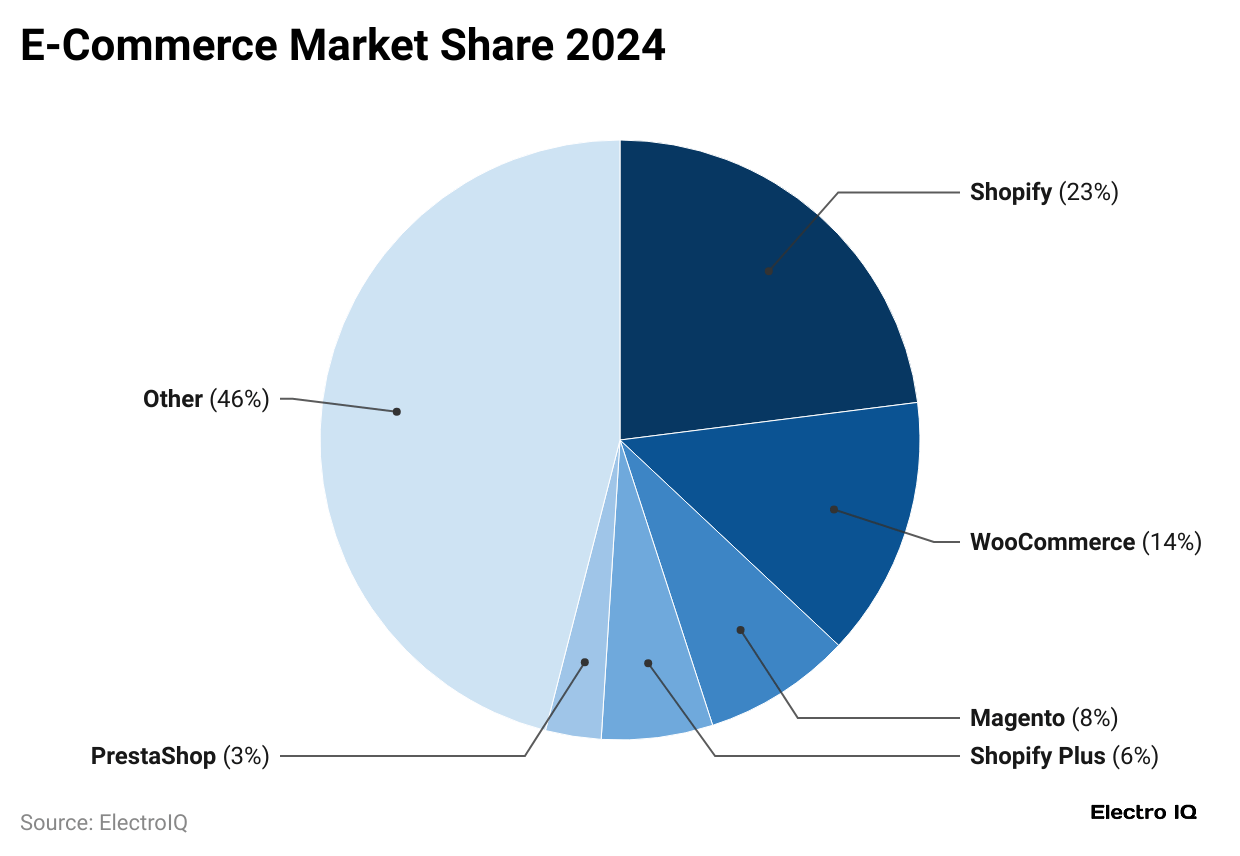
- Magento holds about 8% of the eCommerce market, meaning that around 8 in every 100 online stores use this platform.
Magento Events Timeline
| Date | Events |
| Jan, 2007 |
Development of Magento began under Varien Inc. in California. |
|
Aug 31, 2007 |
First public beta version released. |
| Mar 31, 2008 |
Official general-availability release of Magento. |
|
Jul, 2008 |
Wins “Best New Open Source Project” award from SourceForge. |
| 2010 |
Launch of Magento Professional Edition (later discontinued in 2012). |
|
Feb, 2010 |
eBay acquires an initial 49% stake. |
| Jun 6, 2011 |
eBay completes full acquisition, merging Magento into X.Commerce. |
|
Apr, 2012 |
Co-founder Yoav Kutner departs amid post-acquisition shifts. |
| 2010 to 2012 |
Professional Edition phased out; customers guided to Enterprise Edition. |
|
Nov 3, 2015 |
Permira-led consortium buys Magento, spinning it off from eBay. |
| Nov 17, 2015 |
Stable release of Magento 2, introducing modern architecture and enhanced performance. |
|
Apr 11, 2016 |
Magento Commerce (formerly Enterprise Edition) launched as a managed service. |
| May 21, 2018 |
Adobe announces the acquisition of Magento for approximately USD 1.6 to USD 1.68 billion. |
|
Jun 19, 2018 |
Acquisition by Adobe finalised; Magento integrated into Adobe Experience Cloud. |
| 2019 |
The Magento Association was founded to coordinate over 24 global “Meet Magento” events annually. |
|
Apr, 2021 |
Magento Commerce is officially rebranded as Adobe Commerce, while Magento Open Source remains unchanged. |
| Nov 2, 2023 |
Regular global gatherings like Poland, Brazil, Romania, Malaysia, etc. |
|
Oct 10 to 11, 2024 |
Meet Magento New York City. |
| Oct 31, 2024 |
Meet Magento Netherlands was held. |
|
Jan 24 to 25, 2025 |
Meet Magento India in Pune. |
| Feb 5 to 6, 2025 |
Meet Magento Florida. |
|
Mar 25, 2025 |
Meet Magento France in Paris. |
| May 14, 2025 |
Meet Magento Brazil event. |
|
Jun 10, 2025 |
Meet Magento UK. |
| Jun 26, 2025 |
Magento Association Town Hall (global community livestream). |
|
From Sep to Nov 2025 (Upcoming) |
● On September 4, Meet Magento will take place in Ukraine, followed by the Italy event in Rome on September 25. ● The New York edition is set for October 28. ● In November, the Netherlands will host the event in Amsterdam on the 6th. ● Canada in Toronto on the 13th, Egypt in Cairo on the 16th, and the Philippines on the 19th. |
Active Stores of Magento Statistics by Quarter
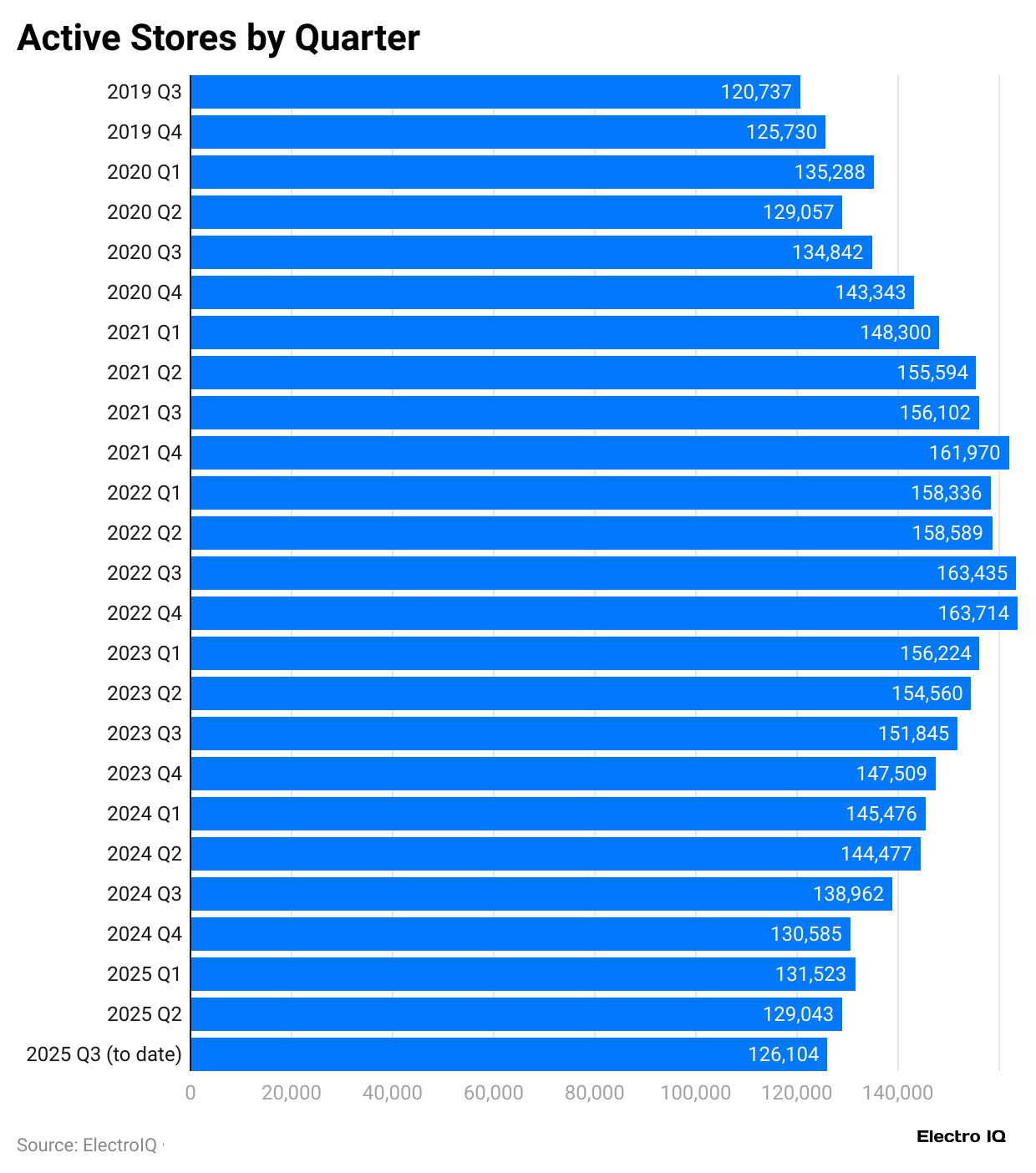 (Reference: storeleads.app)
(Reference: storeleads.app)
- Store Leads data shows that the number of active Magento stores has decreased gradually, as in Q4 2024, there were about 130,585 live sites, which increased slightly to around 131,523 in Q1 2025.
- However, the count dropped to roughly 129,043 in Q2 2025 and further to about 126,449 in Q3 2025 so far.
- Depicting a decline of 2% as compared to last quarter and an 11% year-over-year decrease in Q2 2025.
In contrast, the previous year’s quarterly active stores are mentioned below:
| Year | Q4 | Q3 | Q2 | Q1 |
| 2024 | 130,585 | 138,962 | 144,477 | 145,476 |
| 2023 | 147,509 | 151,845 | 154,560 | 156,224 |
| 2022 | 163,714 | 163,435 | 158,589 | 158,336 |
| 2021 | 161,970 | 156,102 | 155,594 | 148,300 |
| 2020 | 143,343 | 134,842 | 129,057 | 135,288 |
Magento Sales Volume Statistics
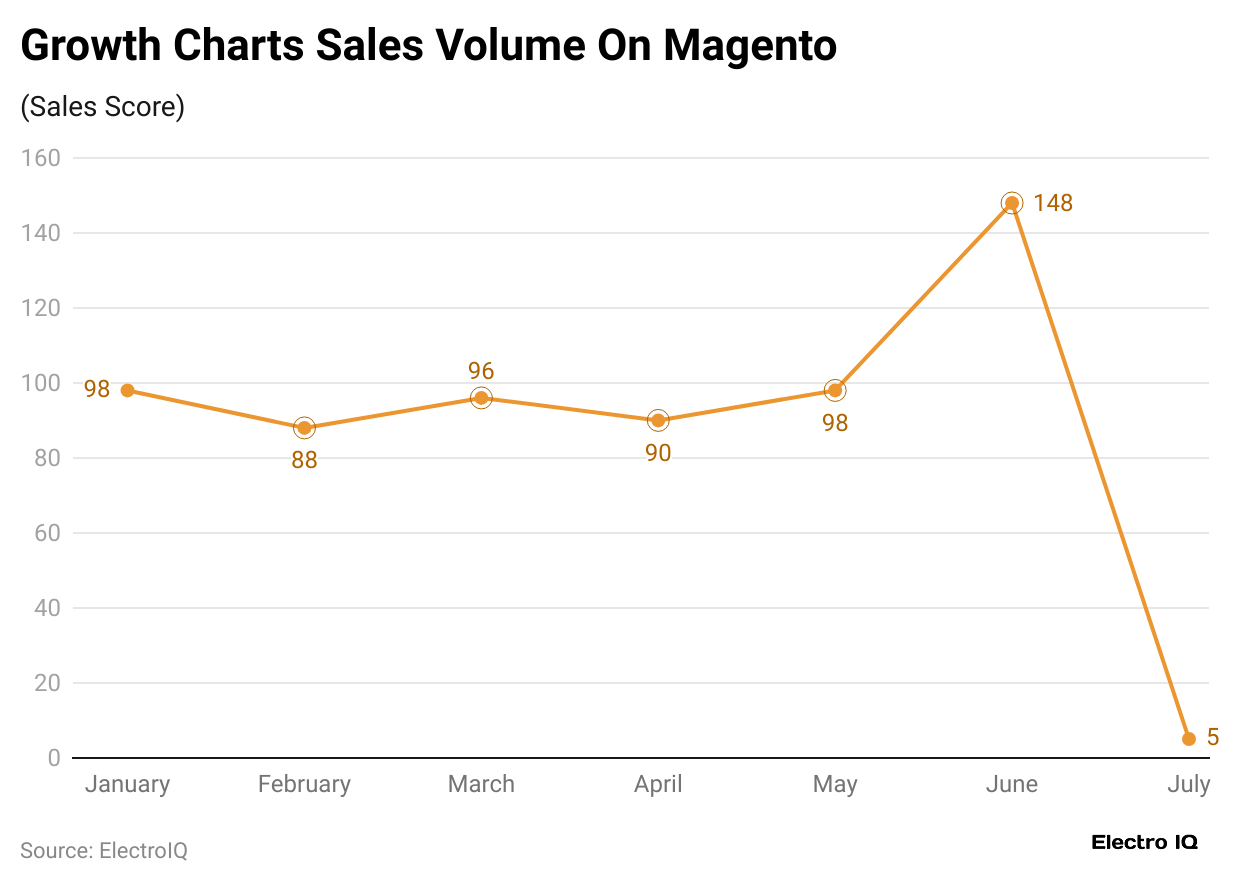
- In January 2024, Magento’s product keyword sales performance made up a score of around 98, and in February, it decreased to 88.
- Moreover, other sales scores in the next few months of 2024 are represented as March (96), April (90), May (98), June (148), and July (5).
Magento Stores Statistics by Social Media Usage
- As of 2025, around 54,188 Magento-based stores connect with customers through Facebook, making up 42.9% of all stores.
- Instagram is the choice for about 47,307 stores (37.4%), while roughly 24,690 stores share content on 19.5% on YouTube.
- Magento stores also use other platforms, including LinkedIn (24,675), Twitter (21,691), Pinterest (9,622), WhatsApp (5,750), TikTok (4,798), Yelp (1,115), Facebook Groups (423), Snapchat (160), SoundCloud (92), and Discord (45).
By Top Apps
- A report published by Storeleads.app shows that around 14,645 Magento stores, making up 11.6% of the total, use the Improved Layered Navigation app.
- The AJAX Cart Pro app is used by about 4,143 stores, or 3.3% of the total.
- Meanwhile, roughly 1,499 stores, equal to 1.2%, have added the Yotpo Reviews app.
- Furthermore, other top Magento Apps by number of stores are followed as Help Desk Ultimate is used by 632, Justuno Pop-Ups & CRO Tools by 172, Request For Quote by 139, Store Switcher by 133, Drip by 111, and Carts Guru by 67.
By Top Categories
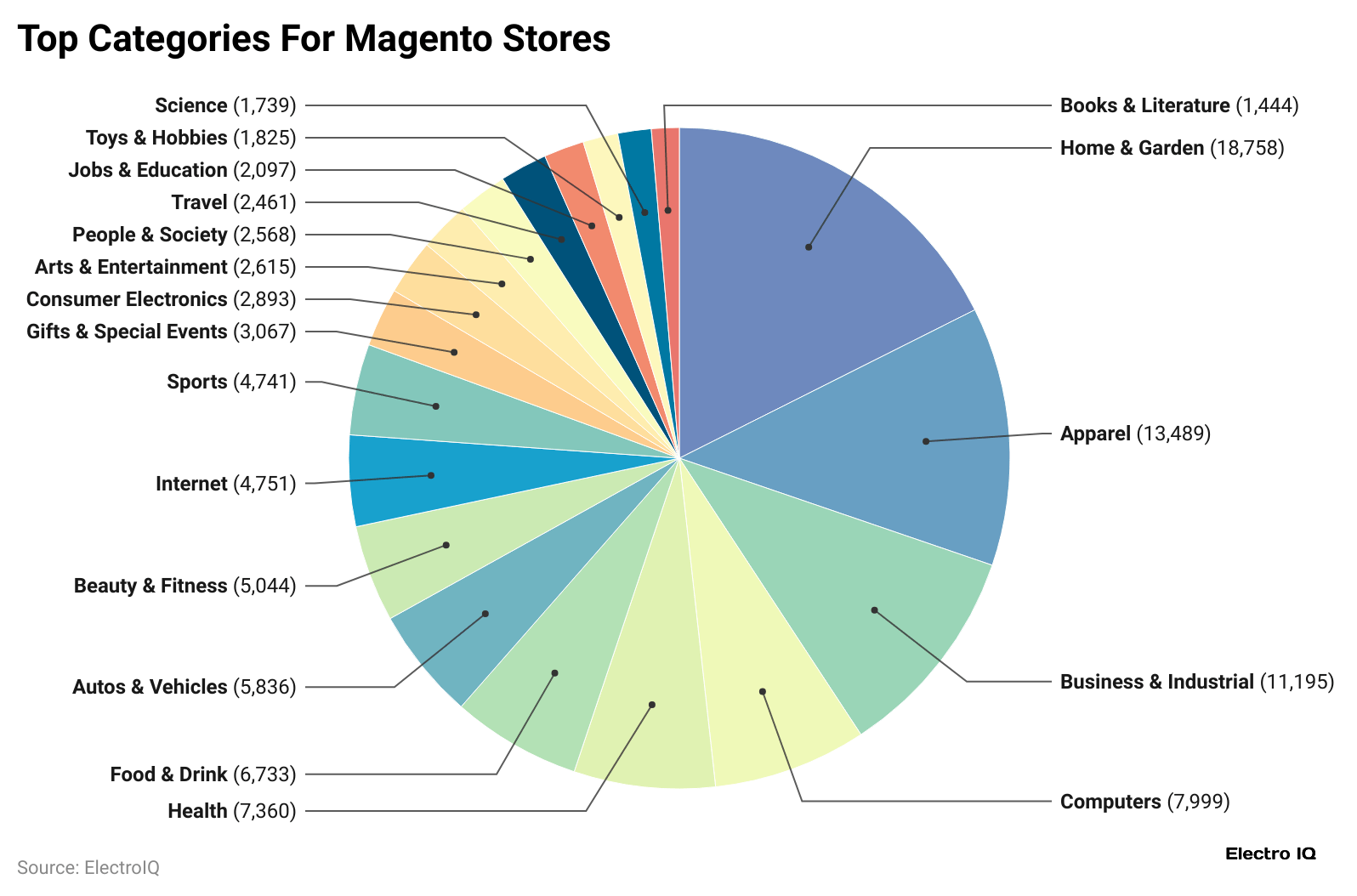
- About 18,744 Magento stores, accounting for 14.8% of the total, focus on Home & Garden products.
- Apparel is sold by around 13,551 stores, representing 10.7%, while roughly 11,209 stores, or 8.9%, specialise in Business & Industrial items.
- The Computers sector has 8,041 stores, and Health features 7,409.
- Food & Drink comes next with 6,739 stores, followed by Autos & Vehicles at 5,862 and Beauty & Fitness at 5,059.
- The Internet category includes 4,779 stores, with Sports close behind at 4,761.
- Other notable segments include Gifts & Special Events (3,075), Consumer Electronics (2,885), Arts & Entertainment (2,623), and People & Society (2,581).
- The Travel sector has 2,452 stores, while Jobs & Education has 2,100.
- Smaller yet significant categories include Toys & Hobbies (1,829), Science (1,744), and Books & Literature (1,457).
By Number of Products Sold
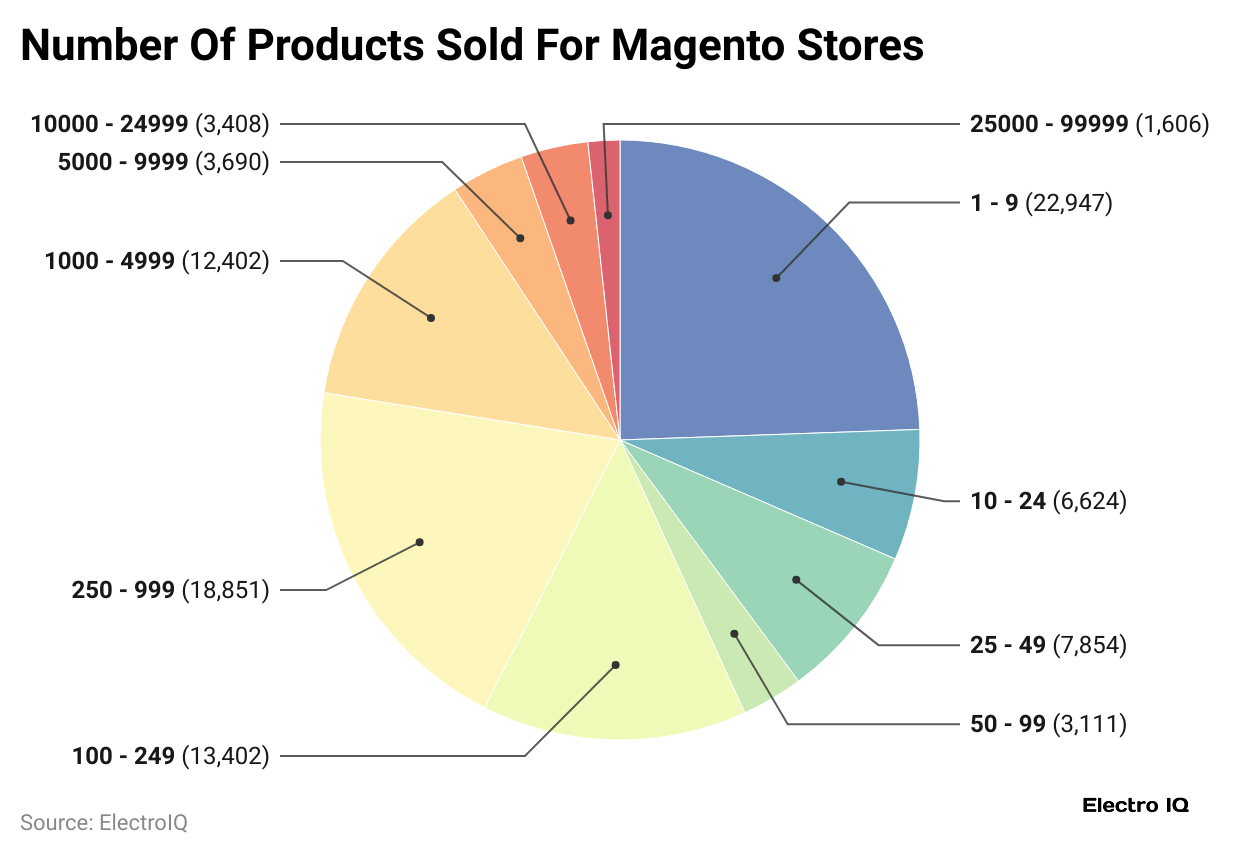
- As of August 2025, most Magento stores do not disclose their employee numbers, with about 85.8% falling into the unknown category.
- Small businesses with 1 to 9 employees make up around 4.3% of the total, while about 2.2% have between 10 and 24 staff members.
- Other stores range from mid-sized teams of 25-49 employees (2,164 stores) and 50-99 employees (2,185 stores) to larger organisations with 1002-49 employees (2,445 stores), 250-999 employees (1,555 stores), and 1,000-4,999 employees (767 stores).
- The smallest group consists of enterprises with over 5,000 employees, resulting in 561 stores.
By Number of Employees
- According to Storeleads.app report analysis, most Magento-powered stores do not share their employee count, making up about 85.8% or roughly 108,517 businesses, in 2025.
- Around 4.3% (about 5,425 stores) are small teams with fewer than 10 staff, while 2.2% (around 2,830 stores) have between 10 and 24 employees.
- Approximately 2,164 Magento stores employ between 25 and 49 people, while about 2,185 have teams of 50 to 99.
- Around 2,445 stores operate with 100 to 249 employees, and 1,555 businesses have staff sizes ranging from 250 to 999.
- Larger enterprises include 767 stores with 1,000 to 4,999 employees and 561 stores with workforces exceeding 5,000.
By Top Technologies
- Over half of Magento stores use popular Google tools, with 54.4% using Google Tag Manager, resulting in 68,795 stores in 2025.
- Meanwhile, 50.4% (63,789 stores) use Google Ads Pixel, and 50.1% (63,319) use Google AdSense.
- Looking at the most widely installed third-party technologies, Google Tag Manager leads with 68,795 stores, followed by Google Ads Pixel in 63,789 stores and Google AdSense in 63,319 stores.
- Other common tools include Google Analytics (44,899), reCAPTCHA (42,731), Facebook Pixel (41,454), Braintree (38,802), Google Pay (32,673), YouTube Player (30,053), and Cloudflare (27,883).
By Top Shipping Carriers
- app further depicts that in 2025, among Magento stores, 8.1% rely on UPS, 6.2% use FedEx, and 5.2% choose USPS for deliveries.
- In numbers, that’s about 10,252 stores using UPS, 7,869 using FedEx, and 6,563 opting for USPS.
- Among Magento stores, 2,513 use Royal Mail for deliveries, while 1,639 rely on Canada Post.
- In contrast, DHL serves 1,184 stores, and 814 choose Australia Post.
- PostNord is used by 640 stores, Correos by 483, and GLS Parcel by 462.
By Top-level Domain
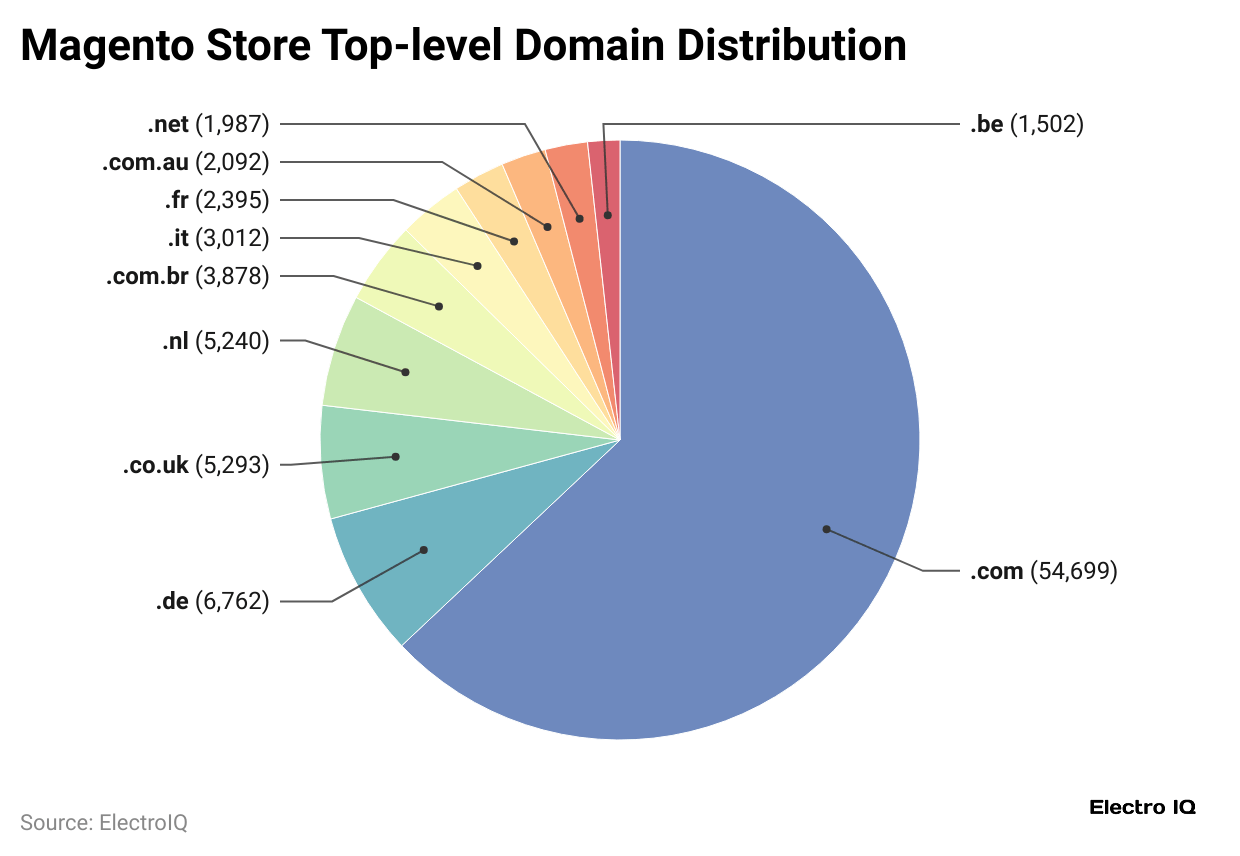
- Most Magento stores use a .com domain, making up 43.4% of all stores, or about 54,840 websites.
- The .de domain is used by 5.4% of stores (around 6,777 sites), while .co.uk is used by 4.2% (about 5,305 sites).
- Other popular top-level domains include .nl (5,249 stores), .com.br (3,880 stores), .it (3,023 stores), .fr (2,398 stores), .com.au (2,093 stores), .net (1,988 stores), and .ca (1,511 stores).
Magento Website Statistics by Country
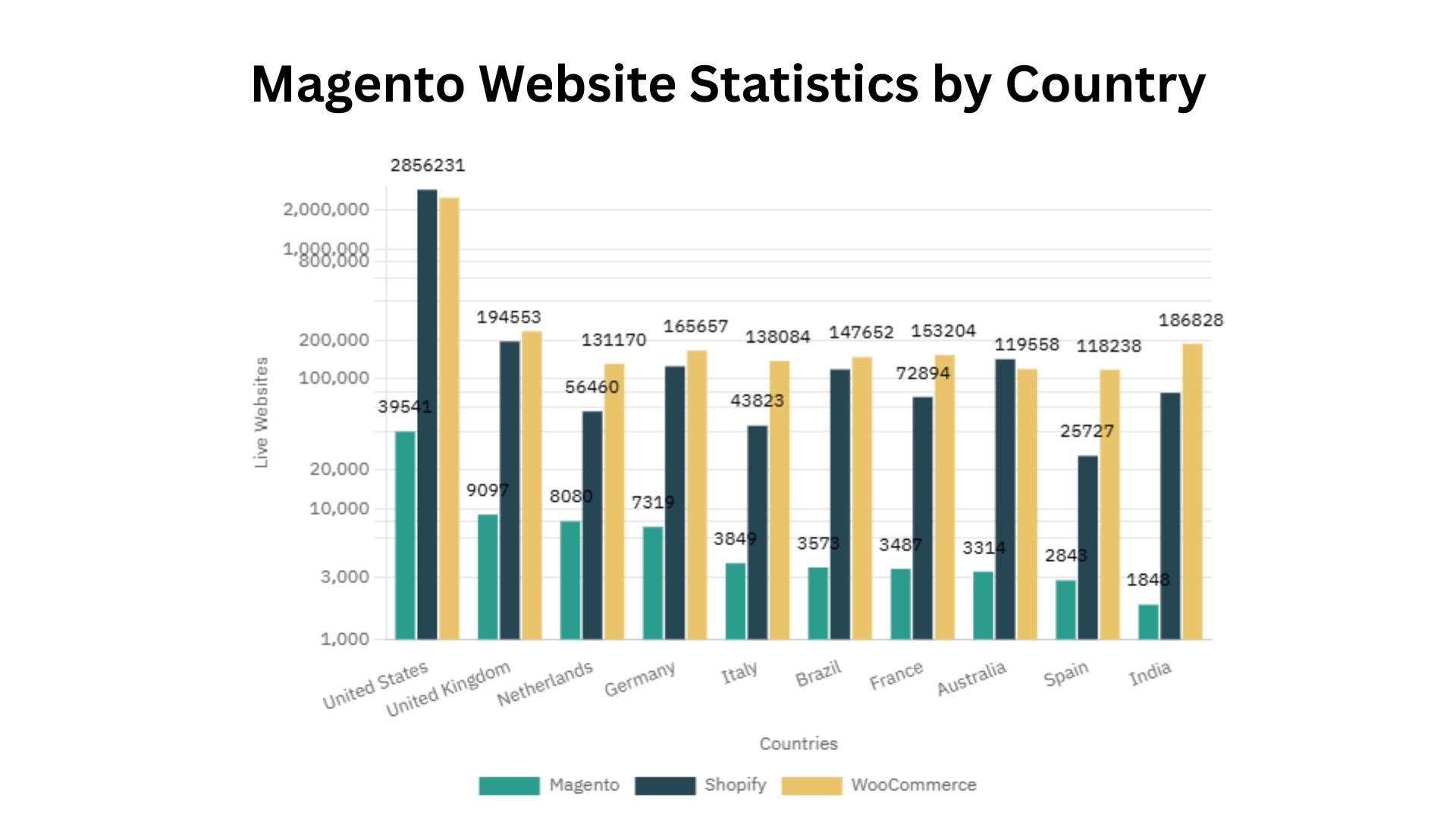
- As of 2025, Magento is used in many countries, with the United States leading at 39,541 live websites (34.04%), as mentioned in the reports of magecomp.com.
- The second and third highest countries are the United Kingdom, which follows with 9,097 websites (7.83%), and the Netherlands, which has 8,080 websites (6.95%).
- Other countries’ websites are followed as Germany: 7,319 (6.31%), Italy: 3,849 (3.31%), Brazil: 3,573 (3.07%), France: 3,487 (3.00%), Australia: 3,314 (2.85%), Spain: 2,843 (2.45%), and India: 1,848 (1.59%).
By Top Categories
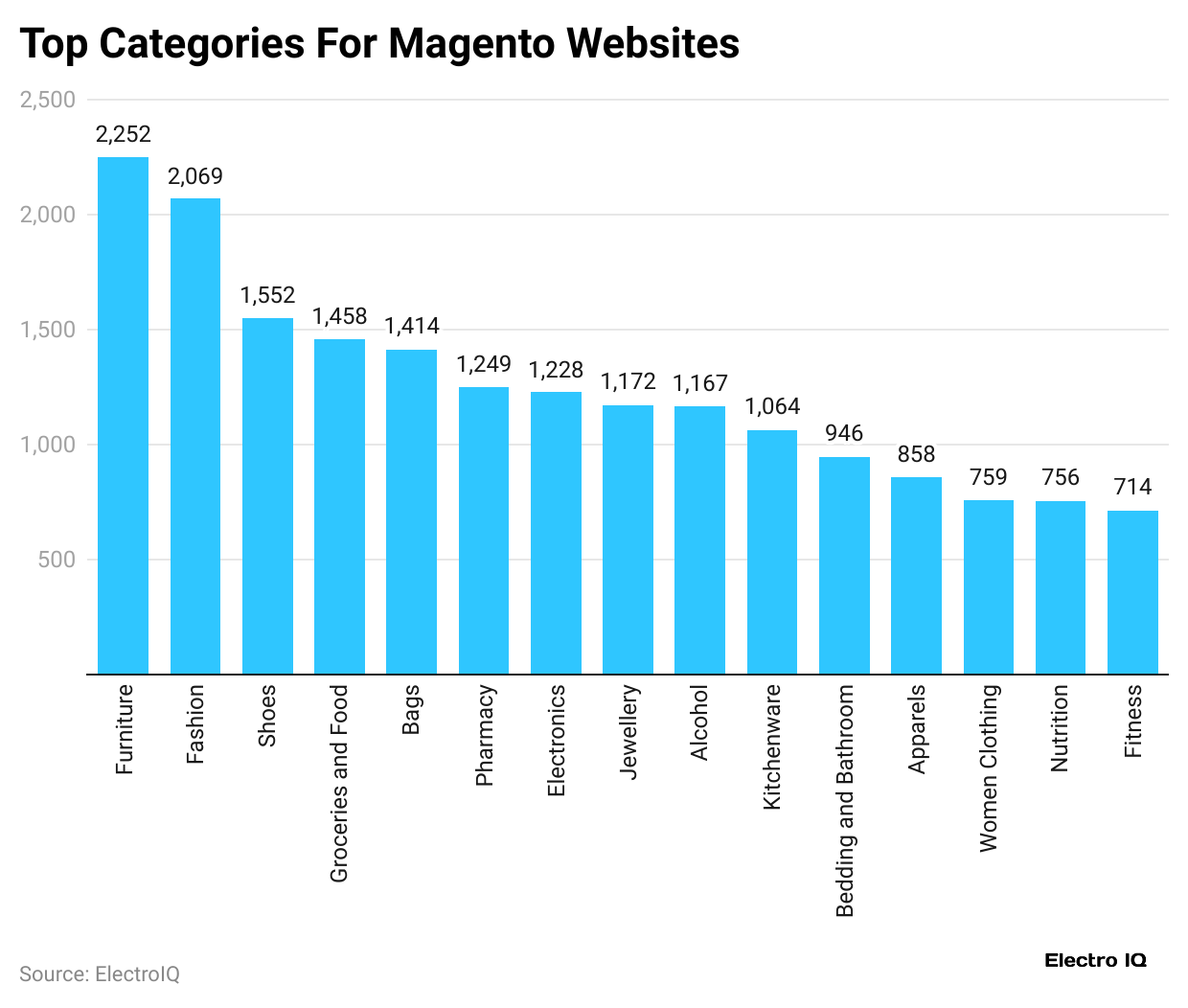
- Among Magento websites, furniture is the most common category with 2,252 sites, followed by fashion with 2,069 sites and shoes with 1,552 sites.
- Furthermore, other categories with several Magento websites are followed by Groceries and Food (1458), Bags (1414), Pharmacy (1249), Electronics (1228), Jewellery (1172), Alcohol (1167), Kitchenware (1064), Bedding and Bathroom (946), Apparels (858), Women Clothing (759), Nutrition (756), and Fitness (714).
Comparison Statistics Between Magento 1 and Magento 2
| Category | Magento 1 | Magento 2 |
| Number of online stores | 148,282 | 91,177 |
| Transactions per hour | 500 | 600 |
| Annual enterprise edition license cost | USD 18,000 | USD 22,000 |
| Key strengths | Superior flexibility and features | Better performance and a more user-friendly interface |
| Top industry usage | – |
E-commerce (25.38%) and Arts & Entertainment (3.53%) |
Magento Marketing Statistics by Google Marketing Tools
- In recent years, about 3,070 Magento websites use Google Optimise 360 to boost site performance.
- 24,542 stores apply 24,542 stores apply Google Conversion Tracking, and 31,072 use Google Remarketing.
- For tracking and insights, 50,782 sites have Magento 2 Google Analytics 4, 271 use Google Analytics Ecommerce, and 2,474 prefer the Enhanced Ecommerce option.
- Google AdSense runs on 3,681 sites, Google Maps appears on 68,370, and 28,761 benefit from Microdata for Google Shopping.
By Email Marketing Tools
- When it comes to email campaigns, 2,449 Magento sites are connected to Marketo Mail.
- MailChimp is in use by 11,568 stores, with 3,962 of them also setting up MailChimp SPF.
- MailJet supports 1,958 Magento websites, while Constant Contact Mail is used by 173.
Magento Performance Statistics
- According to the DigitalSilk report, Magento users earn 29% more revenue from their online platforms and see a 247% boost in return on investment over three years.
- Coca-Cola saw a 50% increase in website traffic compared to the previous year after using Magento.
- T-Mobile boosted its conversion rate by 5% following the switch, while Krispy Kreme almost doubled its annual brand conversions.
- Bulk Powders also made its pages load 32% faster with Magento’s support.
Conclusion
In short, Magento continues to be a popular and strong e-commerce platform, giving businesses the ability to grow with flexible and scalable solutions. Its wide range of extensions and active community support make it easy for stores to improve performance, increase sales, and manage billions of dollars in online transactions every year.
Even though the number of active Magento stores has slightly decreased, the platform’s powerful features and large developer network keep it useful for both small businesses and big companies across the world, helping them succeed in online retail.
Sources

Maitrayee Dey has a background in Electrical Engineering and has worked in various technical roles before transitioning to writing. Specializing in technology and Artificial Intelligence, she has served as an Academic Research Analyst and Freelance Writer, particularly focusing on education and healthcare in Australia. Maitrayee's lifelong passions for writing and painting led her to pursue a full-time writing career. She is also the creator of a cooking YouTube channel, where she shares her culinary adventures. At Smartphone Thoughts, Maitrayee brings her expertise in technology to provide in-depth smartphone reviews and app-related statistics, making complex topics easy to understand for all readers.





